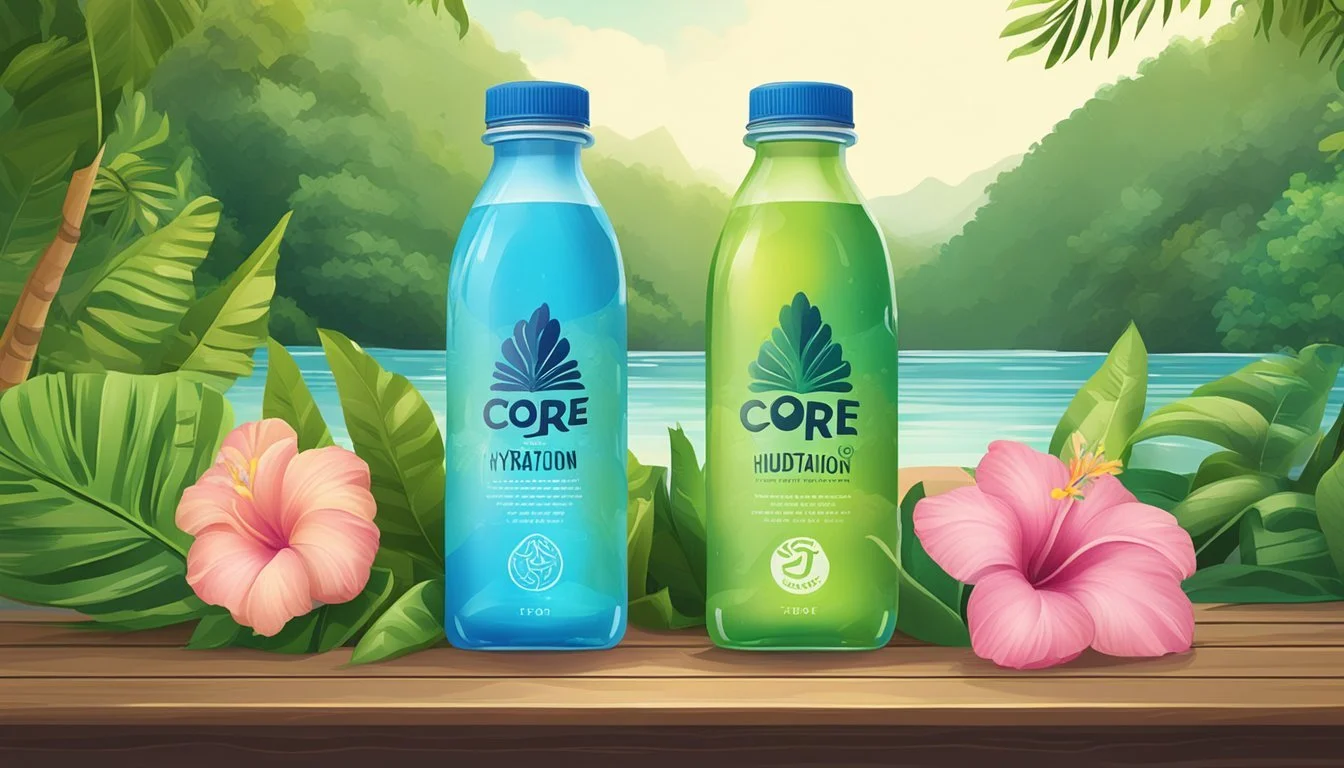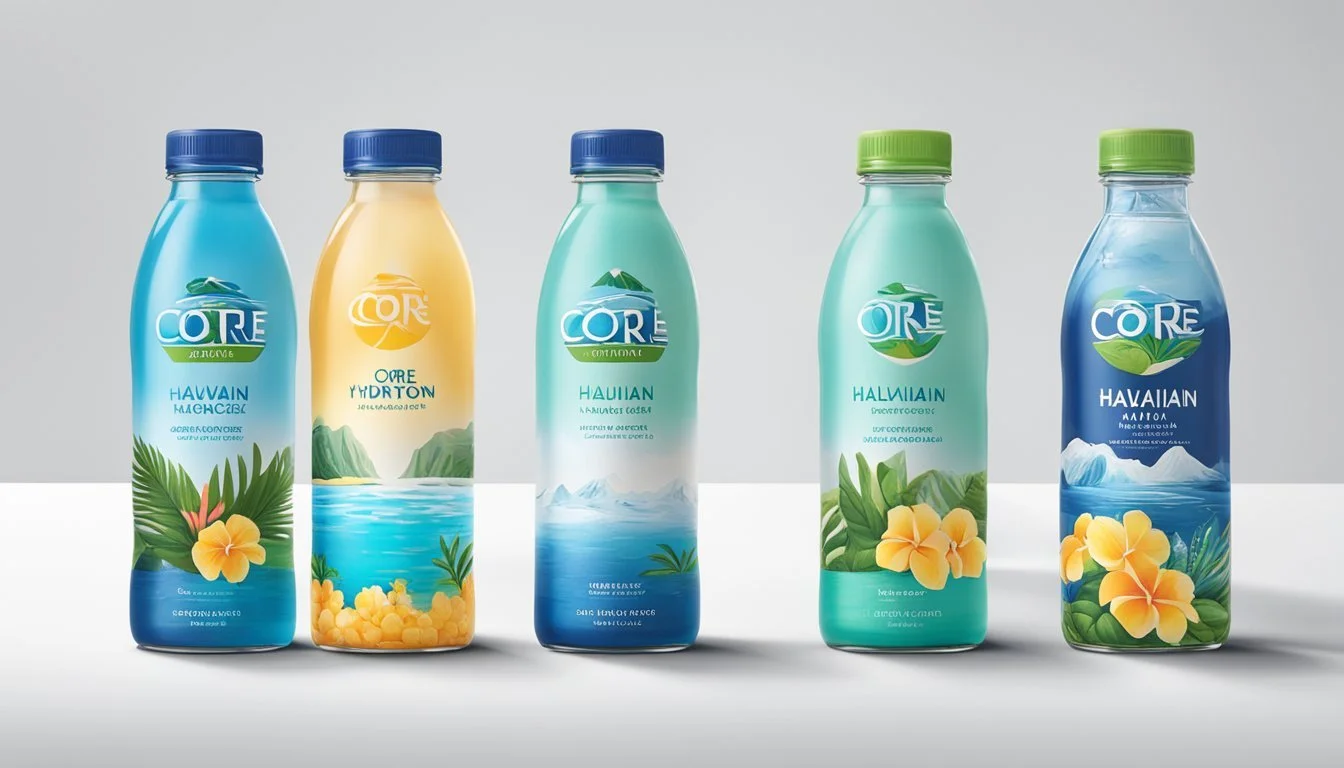Core Hydration vs. Hawaiian Springs
Comparing Premium Bottled Waters
Choosing the right bottled water can make a significant difference in your hydration routine. Core Hydration boasts a perfectly balanced pH level that aligns with the body's natural pH, which typically hovers around 7.4. The water is fortified with electrolytes and comes in BPA-free, 100% recyclable plastic bottles designed for easy grip, making it a popular choice among health-conscious consumers.
Hawaiian Springs, originating from the pristine volcanic fields of Hawaii, offers a taste of nature with its naturally occurring minerals and electrolytes. This brand appeals to those who prefer spring water with a clean, refreshing taste drawn from a sustainable source. It’s not just about hydration but also enjoying the benefits of naturally sourced water.
For those who prioritize optimal pH balance and designed convenience, Core Hydration might be the better choice, while Hawaiian Springs provides a more natural and eco-friendly alternative with its volcanic spring water. Each offers unique benefits tailored to different consumer needs, promising quality hydration to keep you refreshed and invigorated.
Water Source and Origin
Core Hydration and Hawaiian Springs offer distinctly different experiences based on their unique sources and origins. Understanding the specifics behind their sourcing methods and the natural environments from which they originate can help you make an informed choice.
Core Hydration: Sourcing and Purification
Core Hydration sources its water from various U.S. locations. Purified water is the cornerstone of Core Hydration. The company employs reverse osmosis, deionization, and ultraviolet filtration to ensure the water is free of contaminants.
They also claim the water undergoes a uniquely designed seven-stage purification process. This process aims to remove a wide range of impurities, ensuring a neutral pH balance of exactly 7.4, which they tout as perfectly balanced.
Core Hydration focuses on purity and hydration enhancements. They infuse the purified water with essential minerals and electrolytes like calcium, magnesium, and potassium, aiming for optimal hydration benefits. Their advanced purification processes and mineral adjustments set them apart in the bottled water market.
Hawaiian Springs: Natural Source and Purity
Hawaiian Springs water is sourced from the pristine springs in Hawaii. The water is naturally filtered through volcanic rock, adding unique mineral compositions that include magnesium, calcium, and silica, contributing to its alkaline properties.
The water is collected from a deep volcanic aquifer, ensuring it remains uncontaminated and pure. With a natural pH range of around 7.6 to 8.2, Hawaiian Springs offers slightly alkaline water that some consumers prefer for its purported health benefits.
Hawaiian Springs emphasizes minimal processing. The water is bottled at the source, maintaining its natural purity and mineral content. This natural spring water retains its unique taste and composition, attributed to its volcanic origin.
Health and Nutrition
When evaluating Core Hydration and Hawaiian Springs, key factors include pH levels and electrolytes. This section outlines how these aspects can influence the health benefits of each water brand.
Understanding PH Levels
Core Hydration advertises a perfect pH balance of 7.4, which matches the body's natural pH level. This slightly alkaline nature may appeal to those seeking to neutralize acidity in their systems. Hawaiian Springs water typically has a naturally alkaline pH, often around 7.7 to 7.8.
While the body regulates its pH effectively, some proponents believe that alkaline water can help combat acidity and improve overall well-being. Neither water is acidic, which can be a consideration for individuals mindful of their diet’s acid-alkaline balance.
Beneficial Electrolytes and Minerals
Electrolytes such as sodium, potassium, magnesium, and calcium are crucial for hydration and bodily functions. Core Hydration is fortified with electrolytes and minerals that can include magnesium and calcium. These added elements can support muscle function, nerve signaling, and overall electrolyte balance.
Hawaiian Springs, derived from natural springs in Hawaii, is rich in natural minerals. The water contains naturally occurring potassium and magnesium, contributing to its light taste. The presence of these minerals can aid in hydration and support various bodily processes, providing a natural source of essential nutrients.
Comparing Health Benefits
Both Core Hydration and Hawaiian Springs offer distinct health benefits due to their composition. Core Hydration’s pH balance and added electrolytes can make it a good choice for those needing a carefully balanced hydration source. The specific formulation may be beneficial for athletes or those with particular electrolyte needs.
Hawaiian Springs, with its natural alkaline pH and mineral content, provides a pure hydration option. It appeals to those preferring unaltered spring water with its natural minerals intact. The presence of magnesium and potassium in Hawaiian Springs supports cardiovascular health, bone strength, and muscle function.
By comparing these aspects, consumers can choose a water that aligns with their health preferences and dietary considerations.
Taste and Purity
By comparing the taste and purity of Core Hydration and Hawaiian Springs, consumers can better understand the benefits and characteristics of these two popular bottled waters.
Tasting Profiles: Clean and Crisp
Core Hydration is known for its balanced pH, typically around 7.4, which aligns closely with the body’s natural pH. This results in a smooth and neutral taste. Its water provides a clean and crisp drinking experience that many find refreshing.
Hawaiian Springs, sourced from natural Hawaiian springs, offers a more unique taste profile. Its water is described as slightly sweet with a velvety texture. The minerality of Hawaiian Springs gives it a pure, natural taste that stands out among many bottled waters.
Both waters offer distinctive taste profiles, catering to different preferences.
Purity Assessment: Contaminants and Filtration
Core Hydration uses a seven-stage purification process, including reverse osmosis. This advanced filtration method ensures the removal of various contaminants, resulting in pure water. This process guarantees that Core Hydration meets high purity standards.
Hawaiian Springs emphasizes the natural purity of its source water. The springs in Hawaii are naturally filtered through volcanic rock, which is effective in removing impurities. The water is bottled at the source with minimal additional filtration, preserving its natural state.
In terms of purification, Core Hydration relies on modern technology, while Hawaiian Springs leans on natural filtration. Both methods ensure that the final product is of high purity, though the approaches vary significantly.
Packaging and Environmental Impact
When evaluating Core Hydration and Hawaiian Springs, the materials used in their bottles and their environmental implications are crucial. Each brand's approach to BPA content and recycling policies plays a significant role in their overall environmental footprint.
Bottle Materials and BPA
Core Hydration bottles are made from plastic, specifically designed to be 100% recyclable and free of Bisphenol A (BPA). This substance is often avoided due to potential health risks, including hormonal disruptions. The commitment to BPA-free materials ensures consumer safety and meets FDA regulations for chemical leaching.
Hawaiian Springs also utilizes plastic for their bottles but emphasizes using environmentally friendly materials. Their plastic bottles are BPA-free, reflecting a commitment to consumer health. Both brands focus on providing safe drinking options by steering clear of harmful chemicals in their packaging.
Sustainability: Recycling and Waste
Core Hydration's plastic bottles are designed to be recyclable. This aspect helps reduce the amount of waste ending up in landfills and supports broader environmental sustainability goals. The use of 100% recyclable materials shows a commitment to minimizing environmental impact through improved waste management.
Hawaiian Springs also prioritizes sustainability through recyclable packaging. The brand's efforts in promoting recycling contribute to reducing plastic waste. Both brands strive to lessen their environmental impact by encouraging recycling and using materials that support this process effectively.
In summary, Core Hydration and Hawaiian Springs both focus on creating safe, BPA-free bottles while strongly promoting recyclable materials to support environmental sustainability.
Cost and Consumer Access
When examining the cost and availability of Core Hydration and Hawaiian Springs, it's crucial to consider both the price consumers pay per bottle and how accessible these brands are across different regions. Each brand has distinct pricing strategies and distribution networks, impacting consumer reach.
Price Point Comparison
Core Hydration typically positions itself as a premium product, reflected in its price point. A 30.4-ounce bottle usually retails between $1.50 and $2.00. Hawaiian Springs, on the other hand, targets a more niche market, often priced slightly higher at around $2.50 to $3.00 per 30.4-ounce bottle.
Consumers may sometimes find promotional discounts or bulk purchase options, though these can vary by retailer and region. Core Hydration often participates in bulk sales, offering lower per-bottle prices if purchased in larger quantities. Meanwhile, Hawaiian Springs tends to maintain a steadier price given its brand positioning and sourcing exclusivity from Hawaii.
Availability and Distribution Channels
Core Hydration has a broad distribution network. It is widely available in major retail chains across most states and can often be found in grocery stores, convenience stores, and online marketplaces. This widespread availability makes it easily accessible for a large number of consumers.
Hawaiian Springs has a more limited but dedicated distribution channel. It is often available in specialty stores and selected major retailers, particularly in regions with higher demand for premium bottled waters. While it may not be as ubiquitous as Core Hydration, Hawaiian Springs ensures its presence in key markets and online platforms, maintaining a niche yet steady consumer base.
By focusing on broader and niche distribution strategies, both brands manage to cater to their respective consumer segments efficiently.
Brand Analysis and Reputation
When comparing Core Hydration and Hawaiian Springs, it's essential to look at each brand's reputation and consumer perception. This includes their company profiles, brand values, and the loyalty they inspire among their customers.
Core Hydration Company Profile
Core Hydration is known for its focus on pH balance, offering water that aligns with the body's natural pH of approximately 7.4. The company markets its water as ultra-purified using reverse osmosis and carbon filtration.
Core Hydration aims to target health-conscious consumers looking for a balanced and pure hydration option. The company has positioned itself as a premium brand in the bottled water market. Promotional strategies often emphasize purity, balance, and the scientific basis behind their product.
Hawaiian Springs Brand Values
Hawaiian Springs emphasizes its natural source, marketing itself as water drawn from artesian wells in Hawaii. The brand capitalizes on its exotic origin to foster a connection with nature and purity.
Hawaiian Springs prioritizes environmental responsibility, highlighting eco-friendly practices and sustainable sourcing. The brand message emphasizes a pristine, untouched water source, often invoking images of the Hawaiian landscape. This positioning attracts consumers who value natural and sustainable products.
Consumer Perception and Brand Loyalty
Core Hydration has built a strong following among health-conscious individuals. Consumers appreciate the company's clear messaging on pH balance and purity. This has cultivated a sense of trust and reliability, leading to significant brand loyalty.
Hawaiian Springs is perceived as an exotic, premium option due to its natural artesian wells and Hawaiian origin. The brand's commitment to sustainability resonates with environmentally-conscious buyers. This reputation helps Hawaiian Springs maintain a loyal customer base that values both purity and ecological responsibility.
Comparison Summary
Water Taste
Core Hydration is known for its crisp and clean taste, boasting a balanced pH level of 7.4, which aligns with the body's natural pH. Hawaiian Springs, sourced from Hawaiian volcanic springs, offers a slightly sweeter and more mineral-rich taste.
Health and Nutrition
Core Hydration emphasizes its perfectly balanced pH, which may be beneficial for maintaining body's equilibrium. Hawaiian Springs is naturally alkaline and mineral-rich, potentially providing extra health benefits due to its volcanic filtration process.
Environmental Impact
Core Hydration bottles are 100% recyclable. The company also supports clean water initiatives. Hawaiian Springs also focuses on sustainability with eco-friendly practices in its operations and packaging.
Cost
Brand Average Price (per liter) Core Hydration $1.50 Hawaiian Springs $2.00
Bottom Line
Core Hydration offers a versatile and balanced option, making it suitable for daily hydration needs. Hawaiian Springs, with its unique volcanic filtration, appeals to those seeking a natural mineral-rich water.
Signal
Both brands offer distinct choices: Core for balance and Hawaiian Springs for a unique mineral taste. Stay informed about what's inside your bottle and choose according to your preference.






